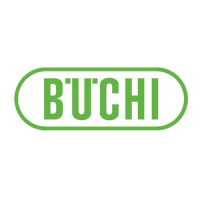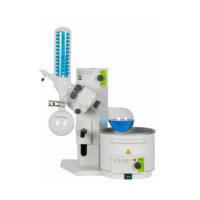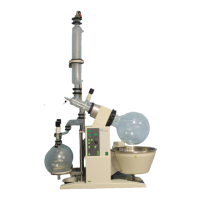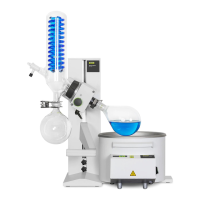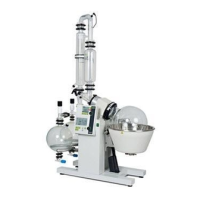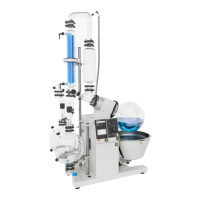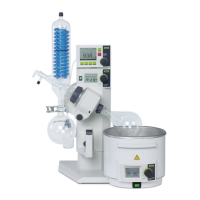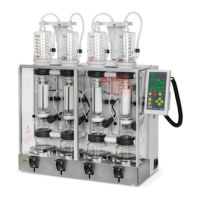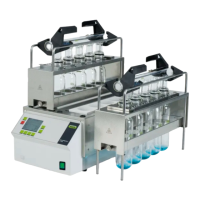Do you have a question about the Buchi Rotavapor R-300 and is the answer not in the manual?
Explains danger levels and signal words used in the manual.
Illustrates and defines warning, directive, and other symbols used in the manual.
Information on obtaining the manual in different languages.
Lists trademarks used in the manual and their owners.
Details the intended operations and applications for the Rotavapor R-300.
Outlines impermissible applications and the associated risks.
Specifies requirements for users and operators for safe device operation.
Details various residual risks including vapors, pressure, heat, and glass breakage.
Recommends wearing appropriate PPE based on hazards.
Warns against unauthorized modifications and emphasizes using genuine parts.
Explains the working principle of the Rotavapor R-300.
Lists available heating bath sizes and interface options for the Rotavapor R-300.
Identifies components of the Rotavapor R-300 from front and rear views.
Explains how the scope of delivery is determined by the purchase order.
Provides technical specifications for the Rotavapor, heating baths, and ambient conditions.
Details safety features like overheat cut-out, overload protection, clips, glassware, etc.
Provides guidelines for safe transportation and checking for damage.
Outlines recommendations for proper storage of the device.
Specifies requirements for the installation location and environment.
Details how to secure the Rotavapor against earthquakes using lashing eyes.
Step-by-step instructions for assembling the vapor duct, gasket, and condenser.
Guides on how to fit and use the glass stopcock for various functions.
Instructions for fitting the optional PTFE stopcock and its functions.
Details on mounting the interface unit for controlling the system.
Instructions for mounting the VacuBox, required for interface operation.
Explains how to fit the LegacyBox for using older peripherals.
Describes how to fit the Woulff bottle for particle/droplet separation.
Details connecting sensors for automatic distillation.
Instructions for fitting the foam sensor to detect and mitigate foaming.
Guides on connecting vacuum and coolant tubing to the system.
Explains how to set up the heating baths (B-301, B-305) on the base.
Details how to fit the protection shield for safety.
Instructions for fitting the splash guard for protection against splashes.
Explains how to connect the Rotavapor and heating bath to the power supply.
Recommends and describes the use of other BUCHI equipment with the Rotavapor.
Explains how to set the maximum temperature and lock the set temperature.
Outlines a quick check to verify installation completion.
Covers preparing the heating bath, fitting flasks, and adjusting the angle.
Covers crucial safety warnings before performing distillation.
Provides a recommended procedure for manual operation.
Explains controlling the system via the Interface I-300/I-300 Pro.
Recommends settings for optimal distillation conditions.
Discusses optimizing the distillation process based on solvent.
Instructions for adding solvent while distillation is in progress.
Step-by-step guide to safely finish the distillation process.
Details the procedure for safely removing the evaporating flask.
Instructions for safely removing the receiving flask.
Guides on inspecting and cleaning the vapor duct for damage and residues.
Explains how to perform a leak test and identify issues.
Provides instructions for cleaning the optional splash guard.
Details on fitting GL14 cap nuts and tube seals correctly.
Explains when to clean or replace seals and how to inspect them.
Provides methods for cleaning glass components safely and effectively.
Outlines when and how to clean the heating bath bowl.
Instructions for cleaning the glass part of the Woulff bottle.
Guides on draining fluids and drying the system before storage.
Details the process for updating the device firmware using BUCHI tools.
A troubleshooting guide listing common faults, their causes, and solutions.
Guides on resetting overheat cut-outs and replacing fuses.
Procedures for safely taking the device out of service.
Guidelines for the proper disposal of the equipment.
A table listing various solvents with their properties for distillation.
Lists spare parts, accessories, glass assemblies, and wearing parts for the device.
Provides a list of abbreviations used in the manual.
Information on health and safety approval and declaration requirements.
Declaration requirements for safety, hazards, and disposal of waste.
Information regarding the introduction training for Rotavapor users.
| Brand | Buchi |
|---|---|
| Model | Rotavapor R-300 |
| Category | Laboratory Equipment |
| Language | English |
